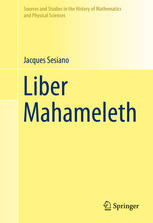

Most ebook files are in PDF format, so you can easily read them using various software such as Foxit Reader or directly on the Google Chrome browser.
Some ebook files are released by publishers in other formats such as .awz, .mobi, .epub, .fb2, etc. You may need to install specific software to read these formats on mobile/PC, such as Calibre.
Please read the tutorial at this link: https://ebookbell.com/faq
We offer FREE conversion to the popular formats you request; however, this may take some time. Therefore, right after payment, please email us, and we will try to provide the service as quickly as possible.
For some exceptional file formats or broken links (if any), please refrain from opening any disputes. Instead, email us first, and we will try to assist within a maximum of 6 hours.
EbookBell Team

0.0
0 reviewsThe Liber mahameleth is a work in Latin written in the mid-12th century based (mainly) on Arabic sources from Islamic Spain. It is now our principal source on mathematics in Islamic Spain at that time; There are few extant Arabic texts and no one is as complete as the LM. It is also the second largest mathematical work from the Latin Middle Ages (the other is by Fibonacci, some 50 years later).
Since the three main manuscripts preserving it are incomplete and there are many scribal errors, a reliable Latin text has been established, which reports (in notes) the various readings of the manuscripts and the errors in them. This is how a so-called critical edition is made. This edition of the Latin text is preceded by General Introduction, describing the various manuscripts, the content of the work and what we know about its author.
Part Two of the volume is a translation of the text and ends with a glossary of Latin terms. The glossary will be of great importance for the knowledge of Latin scientific terms from that time, since there is no other mathematical text of this size from the 12th century. Part Three begins with a short introduction and then analyzes all the problems from the text, with a summary of the mathematical methods involved in each chapter. The commentary is a companion to the translation and explains the author's solving methods.